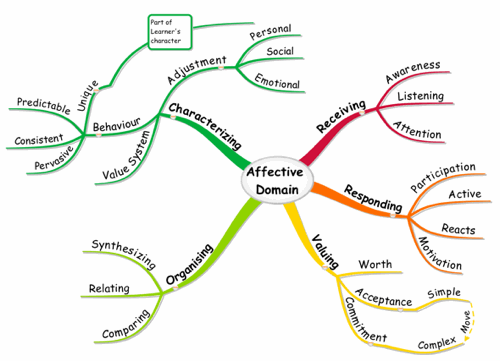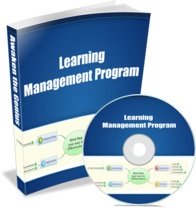Mind Map of The Affective Domain

Get Access to the Best Mind Mapping Tips, Tools, Techniques Resources and Opinions. Study Skills and is the foundation for the rest of the Domains as defined in Bloom's Taxonomy.
It also form the bases of our Learning Management program, which gives you practical steps to develop the Affective Domain.
As stated in the previous article on Bloom's Taxonomy, the acronym KSA (Knowledge, Skill, Attitude) is often used to remember Bloom's Taxonomy. The affective domain is represented by 'attitude' in the acronym. This is not entirely true, as it involves far more than just attitude.
I believe that affective domain is the foundation on which learning is based and I am therefore covering it first.
The affective domain can be divided into five categories, each building on the previous one. The characteristics are also arranged from the most simplest to the most complex.
Receiving can be summarized by the key words awareness, listening and paying attention.
It starts with being aware of the fact that you have to 'receive' the information in order to learn it. You must be willing to listen and pay selective attention to what is being learned.
Without this, you cannot even embark on the learning process. All learning comes to a standstill. It is therefore the foundation for all learning.
The willingness of a learner to receive knowledge is largely governed by attitude. This is probably why attitude often becomes the overriding Key Word of this learning domain.
Once you are aware of the fact that you must learn, you must still listen and pay attention if you are being taught by someone.
If you are doing self study, you have to motivate yourself to pay attention when receiving the information, which may be the reading of the subject matter.
Examples:
The next step in the learning process is responding by active participation. Learning cannot be a static one way process. If you simply sit in the class and listen passively, minimum learning will take place.
You have to react to what the teacher, lecturer, or writer is saying and start applying and practising the new principles.
Examples:
This is the worth or value that you attach to what you are learning. It starts by simple acceptance of the fact and ends with the more complex state of commitment.
If you have internalized what you have learnt based on your own set of values, deeper learning would have taken place.
This will become evident in your behaviour and is often identifiable by others.
You can then use this new found learning to solve problems and propose solutions. You will feel strongly about the subject and therefore apply your knowledge with commitment.
If, for example, you've become sensitive to cultural diversity during your learning. You become a spokesperson in your company to promote cultural diversity. You start influencing company and policy procedures regarding cultural diversity, etc., etc.
Examples:
This is evident by contrasting different values, solving conflict between them and creating your own unique value system.
It is based on comparing, relating and synthesizing these values.
You will have to prioritize the values based on practicality and your desire.
Examples:
This is when your value system controls your behaviour. Your character is guided by your value system. Your behaviour becomes consistent and predictable. It becomes characteristic of you as a person and determines how you react personally, socially and emotionally.
Examples:
The affective domain of Bloom's taxonomy is the foundation for the cognitive and psychomotor domains. It enables you to take your learning from basic passive reception to internalised characterization.
I believe that Mind Maps naturally allow you to do this. By simply constructing a Mind Map of any topic, you naturally incorporate these principles, but by knowing the principles and applying them when doing your Mind Map notes, you can wilfully apply the different levels of learning in your learning process.
Continue to explore the different uses of Mind Maps in your everyday life. This will ensure that the depth and width of your knowledge naturally increases.
By having a learning management program, you can also ensure that your learning is well structured and well managed.
Next article in the Bloom's Taxonomy Study Skills series: Mind Map of the Cognitive Domain.
Return from Study Skills - Affective Domain to Using Mind Maps Home Page
Subscribe to Using Mind Maps
Receiving
Responding
Valuing
Organizing
Characterizing
Conclusion
Return from Study Skills - Affective Domain to Using Mind Maps Home Page




